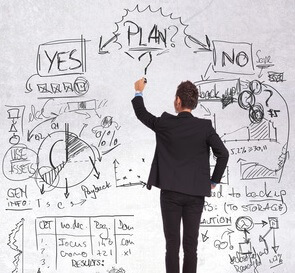 Do you find that you are nervous before starting a facilitated session? I do, too – despite having facilitated well over 500 sessions. There is a difference, however, between the nervousness during my first year of facilitation and the nervousness I have now 30 years later. It has to do with whether or not you know your process.
Do you find that you are nervous before starting a facilitated session? I do, too – despite having facilitated well over 500 sessions. There is a difference, however, between the nervousness during my first year of facilitation and the nervousness I have now 30 years later. It has to do with whether or not you know your process.
The first few times I facilitated, my internal voice was saying, “WOW. I’m nervous. I’m about to try to facilitate this group? Is it going to go well? Do I know what I’m going to say? Am I really prepared? What if I blow it? What if I stumble or say something wrong? What if…?”
Sound familiar? Do you have an internal voice that sounds like this too? Well, these days, the nervousness is still there, and the internal voice is still active. But, it’s different: “WOW. I’m nervous… Hmm, I wonder what’s for lunch?”
Why the difference? Well, of course, experience helps a lot. But, I think there is another major factor involved. Over time, I learned that a significant factor impacting my nervousness was whether I felt prepared. I know now to address this by making sure I “know my process cold.”
How Do You Ensure You Know Your Process Cold?
Our professional facilitators use the acronym, OPQRST, to make sure we know our process cold. You may find it helpful as well.
Order Do you know the order of your agenda items? For example, if you are doing process improvement to help an organization improve its hiring process, can you close your eyes and say each of your agenda items in order?
- How does the hiring process work today?
- What are the strengths?
- What are the problems and root causes to those problems?
- What are potential improvements we could make?
- Which improvements will we make?
- What will the new process look like?
- How will we determine if the new process is successful?
- What are the steps for implementing the new process?
Process Do you know the process technique that you will use for each agenda item? For example, you might use the dump-and-clump activity for getting the participants to define how the process works today and rotating flip charts for identifying potential improvements.
Question Have you developed the “Type B” starting question you will use for each agenda item? (Start with an image-building phrase, expand the image to the answers, ask the direct question.) For example, your starting question for how the process works today might be: “Think about the last time you hired someone. Think about all the activities you had to go through to bring that person on board, all the steps you had to complete… What are the steps in the current hiring process?”
Recording Have you defined the recording method you will use to document the responses participants give for each agenda item? For example, with problems and root causes, you might use three columns (problem, symptom, root cause). For dump-and-clump on how the process works today, you might use two flip charts, each divided into six cells.
Supplies Have you determined the supplies you will need for each agenda item? For example, you might use dots to determine which improvements will be implemented, sticky notes for rotating flip charts, and hard stock paper for name cards.
Timing Do you know the expected start time and estimated duration for each agenda item? We recommend estimating the duration using a process such as the following:
| Introduction Time |
+ | Number of Units |
x | Time per Unit |
+ | Wrap-Up Time |
= | Estimated Duration |
| 3 min | 15 | 1 min | 2 min | 20 minutes |
As an example – if we are doing a brainstorming activity, we might expect it to take us three minutes to introduce the topic, two minutes to wrap it up when we are done, about 15 items expected (requiring one minute per item), then this brainstorming activity should take about 20 minutes.
When I am prepared in this way, I find that the nervousness that accompanies nearly every assignment I have becomes like an old friend that is present just to keep me on my toes. I can be more relaxed and feel more confident because I know that I know my process cold.
Learn more facilitation skills and techniques like this in our course, The Effective Facilitator. This four-day course provides a structured approach for leading teams and facilitating meetings and covers over 100 techniques for getting amazing results with your groups.
Contact us if you’re ready to learn more group facilitation techniques to elevate the results from your team.
About the Author
Michael Wilkinson is the trailblazing Founder of Leadership Strategies, renowned as the foremost provider of professional facilitators and facilitation training in the US. As a Certified Master Facilitator and a Certified Professional Facilitator, Michael’s expertise is in high demand as a trainer, facilitator, and keynote speaker. With a track record of leadership in the facilitation industry, including roles as past president of the Southeast Association of Facilitators, creator of the FindaFacilitator.com database, and founding board member of the International Institute of Facilitation, Michael is a leader in the industry. Dive deeper into his wealth of knowledge through his acclaimed books, including The Executive Guide to Facilitating Strategy, The Secrets of Facilitation, The Secrets to Masterful Meetings, and CLICK: The Virtual Meetings Book.


